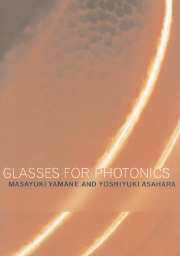5 - Magneto-optical glass
Published online by Cambridge University Press: 30 July 2009
Summary
Introduction
The research into materials with a high magneto-optical effect is always an interesting matter because these materials are extensively used as magnetic field sensors and optical isolators. Glass materials are of interest for these applications because they are transparent in the visible and near infrared spectral region and can be readily formed into complex shapes such as optical fibers. One of the magneto-optical effects, the Faraday effect in glass is a well-known phenomenon. The primary trend of the studies is, therefore, to develop and produce glass compositions having a large specific Faraday rotation and low absorption in the visible and near infrared regions.
Generally the Verdet constant, a measure of the Faraday rotation of the materials, is considered to be of two types depending upon the ion or ions that are incorporated in glass: diamagnetic or paramagnetic. Most normal network former and modifier ions in glass would give rise to diamagnetic rotation. The rare-earth and transition ions are examples of paramagnetic ions. Diamagnetic glasses generally have small and positive Verdet constants, which are almost independent of temperature, whereas paramagnetic glasses usually have large and negative Verdet constants, which are generally inversely proportional to temperature. The Faraday effects of various glasses are presented and discussed in this chapter.
- Type
- Chapter
- Information
- Glasses for Photonics , pp. 242 - 266Publisher: Cambridge University PressPrint publication year: 2000
- 1
- Cited by

